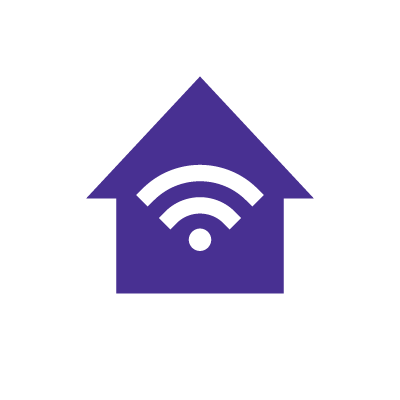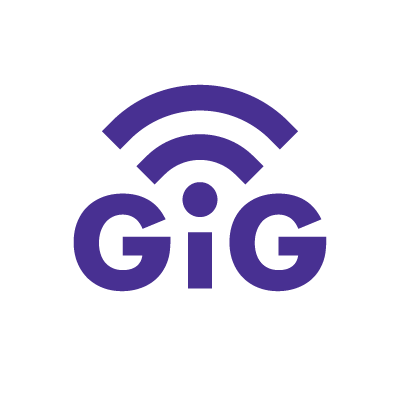Why Is My Internet Slow?

Having a slow internet connection is a major setback. Common problems like slow-loading webpages, slow download and upload speeds, dropped video calls and buffering when streaming high-quality content can be frustrating and significantly affect productivity.
Identifying the leading causes of slow internet speeds is the first step to finding practical solutions.
Some causes include:
-
- Network congestion
- Outdated hardware
- Too many background applications running simultaneously.
This article will outline some causes of slow internet speeds and recommend solutions and tips for diagnosing and fixing issues affecting your internet speeds.
Switch & save
Astound is the #1 cable ISP
Stream live content, work, surf, game and connect to multiple devices with speeds up to 1500* Mbps through our ultra‑reliable fiber‑powered network.*

Frequent reasons for slow internet
Have you ever wondered why your internet is slow? Understanding the factors that lead to slow internet connections can help resolve speed issues. Here are some of the common reasons why your internet might be slow.
Network congestion
Network congestion occurs when many users try to access the internet simultaneously, straining the shared bandwidth. Network congestion is more likely during peak hours, such as in the evenings or high-traffic events.
During these periods, some Internet Service Providers (ISPs) may employ network traffic control measures such as throttling, which can decrease the speed of your connection.
Additionally, emerging technologies like 5G home internet experience slow speeds due to network congestion. The slow speeds are apparent in densely populated areas where cellular and home internet users compete for 5G signals, reducing internet performance.
Outdated hardware
Outdated modems, routers or network adapters can cause drastically reduced internet speeds. Old devices often cannot support recent internet upgrades like WiFi 6, which has significantly improved internet speeds and bandwidth capacity.
Learn more: The latest WiFi standard
This is why it’s important to regularly update the firmware on your devices and consider replacing them if they are too old to support the latest WiFi standards.
Interference from other devices
Many electrical devices can disrupt wireless signals. Common household appliances like microwaves, Bluetooth devices and speakers operating on the same 2.4 GHz frequency band as the routers can interfere with wireless signals, weakening the connection and leading to slower internet speeds.
Distance from the router
The further you move away from the router, the weaker the WiFi signal becomes. Thick walls and multiple floors obstruct the WiFi signals, leading to signal degradation. Signal degradation results in slower speeds and frequent dropped connections.
To maintain the strength of the signals as you move away from the router, consider using a mesh WiFi system to extend the WiFi coverage and maintain signal strength throughout your home.
Too many connected devices
As you increase the number of devices connected to your router, the available bandwidth for each device decreases. Having too many devices running at the same time can slow your speeds significantly, especially if the devices are simultaneously performing data-intensive tasks such as online gaming and streaming 4K quality content.
Background applications and updates
Idle applications and operating systems that perform updates or background operations consume a lot of bandwidth without your knowledge. For instance, downloading large files, installing online updates and synchronizing with a cloud service in the background can slow down your internet speed, particularly if these processes are running simultaneously.
WiFi that just works!
WiFi plans for any home
Tiny, large or somewhere in between; find WiFi coverage to fit any space. Blanket your entire home with a fast and ultra‑reliable connection.

Diagnosing your slow internet
Now that you know what can cause a slow internet connection, it’s time to diagnose where the problem is in your network.
Running speed tests
Start with a speed test to measure your current internet speed. Speed tests will help you determine whether your current download and upload speeds match what your ISP provides. Run the speed tests at different times of the day on various devices to gain insight into the consistency of your connection.
Be sure to run your tests with your VPN on and then again when it’s off. The VPN encrypts your internet traffic, making it difficult for ISPs to identify and potentially throttle the connection. If the speeds are better when the VPN is active, your ISP might be throttling your connection.
If your speeds frequently fall below what your plan promises, you should contact your ISP. Keep track of your speed test findings and share them if necessary.
Checking for device issues
Sometimes, a slow internet speed experience stems from a device rather than a network issue. Test your internet connection on multiple devices to determine if the problem comes from a specific device. Also, update your devices’ software and install antivirus software to search for and eliminate any malware that might consume bandwidth or slow down the device.
If you notice an increase in speed on one device compared to another, the problem is probably with the latter. Focus on troubleshooting the faulty device.
Analyzing network traffic
You can use your router’s admin interface to monitor connected devices and their bandwidth usage. Some routers have features such as traffic monitoring and Quality of Service (QoS) functions that can help you monitor and dedicate traffic and bandwidth to specific devices or applications.
Pay attention to background processes and programs on your devices that might consume bandwidth without you noticing. Such insights can help you adjust network and bandwidth usage settings accordingly.
Find your speed
What speed do you need?
Maybe you just need the essentials—or maybe you need to unleash the ultimate internet speed. Explore your options to get the best experience for every device in your home.

Solutions to improve internet speed
Once you’ve diagnosed the reason for your slow internet speed, you can follow the below solutions to improve it.
Upgrading your hardware
Replace older devices with newer ones, such as routers and modems compatible with WiFi 6 or higher. Modern routers and modems support faster internet speeds, lower latency, higher bandwidth and device capacity and broader network coverage.
Upgrade your primary devices to enhance your internet experience. Newer device models provide better hardware capabilities and support the latest WiFi technologies and faster internet speeds.
Optimizing router settings
Modern routers provide several features you can tweak to increase WiFi speeds. Some measures include changing the WiFi channels to avoid interference from surrounding networks or modifying QoS settings to allocate bandwidth for essential applications like video calls or gaming.
If you are a competitive gamer and experience slow internet speeds with your current router, consider using a gaming router to optimize your internet connection and enhance your gaming experience.
Reducing interference
Move the router to the center of the house, away from electronic devices that might interfere with the WiFi signals. Place the router in a raised position, such as on top of furniture or shelves, to provide unobstructed coverage.
In addition, use a wired Ethernet connection for devices that require high speed and consistent performance. Wired connections are less prone to electromagnetic interference and offer more stable, reliable and faster internet speeds than wireless connections.
Managing connected devices
By minimizing the number of connected devices within a network and ensuring that idle devices are disconnected, you reduce the strain on your connection. You can use parental controls to manage devices or set up guest networks to separate traffic from your primary network.
Astound’s Whole Home WiFi with eero subscription comes with eero Secure, which has parental controls, the ability to set up guest networks and more, at no additional cost.
Contacting your internet service provider (ISP)
If the above troubleshooting attempts fail, contact your ISP for assistance with possible network problems or to help find the best internet speed for your needs. Remember to document your troubleshooting measures and speed test results before contacting your ISP, as this information will help them resolve your issues quickly.
Learn More: What is the difference between WiFi and the Internet?
Potential external factors
Some factors that affect your internet speeds could be outside your immediate control. Some of the external factors that could affect your connection are below.
ISP throttling
Some ISPs purposely limit your internet speed during peak hours or when you exceed certain data usage limits. If you suspect your ISP is throttling your internet, conduct a speed test at different times and verify the results. Consider calling your ISP and switching to a higher speed tier.
Issues with the internet infrastructure
Slow internet connections can result from the quality of infrastructure your ISP provides, such as cables and networking equipment.
Issues with internet infrastructure, including outdated or damaged hardware, planned equipment maintenance or upgrades or natural disasters that affect the infrastructure, can significantly influence the quality of your internet service. Try to stay updated about developments in your area, such as the implementation of new internet technologies or announcements of outages.
Additionally, if you live in a remote or rural area, the infrastructure to support fast internet connections like fiber and cable or wireless connections like 5G home internet might not be available, which limits your access to these connections
Build your plan
Your perfect plan is just a click away
Get the speeds, WiFi, mobile and TV plans you need all at an affordable price. Bundle your services with Astound and see how much you can save.

Conclusion
Slow internet speeds are annoying and can have various causes, ranging from network congestion and old hardware to signal interference and multiple devices running in the background. Once you understand these causes, diagnosing and addressing them is easier.
Take a proactive approach to analyzing and handling these issues.
Run speed tests and device checks to diagnose where the problems stem from. Then, implement solutions to improve your internet speeds, such as upgrading your hardware, optimizing the router settings and managing connected devices.
If the problems persist, contact your ISP, as they may indicate external factors, such as the ISP throttling or issues with their infrastructure.
Frequently asked questions
How can I tell if my ISP is throttling my internet?
First, conduct a speed test on the internet connection at different times of the day and compare the results. You can also use a VPN to compare the speeds of the networks. Run the tests without a VPN and then run them again while it is on. If you notice improved speed with the VPN, it might indicate that your ISP is likely throttling your connection.
Will a Mesh WiFi system help with slow internet?
Yes. Mesh WiFi improves signal quality and expands your WiFi range to dead zones with minimal WiFi network. A mesh system will be helpful if the internet is slow due to a weak WiFi signal. However, a mesh system does not increase the speed of your internet plan.
How often should I reboot my router?
You should reboot your router at least every two weeks or once a month to clear the cache and install any updates available.
Can viruses or malware slow down my internet?
Viruses and malware can slow down internet speeds. They can use your network’s bandwidth, change your network settings and even control your connection.
What is the difference between WiFi speed and internet speed?
WiFi speed is the data transfer rate between your device and the router. Internet speed is the rate data transfers from the router to the internet. Learn more about WiFi and internet speeds.
Create the perfect bundle
Get the speed, WiFi, mobile and TV that’s just right for you.
*Internet speeds vary, not guaranteed. Certain equipment may be required. See astound.com for details. Modem req’d. No contracts. Astound Internet is powered by fiber and connected to the premises via coaxial connection or fiber, where available. Delivery methods may vary by area. Subject to availability. Ltd-time offer; subj. to change without notice. Internet speeds under 1 Gig, pricing valid for 12 mos. Gig+ Internet speeds, pricing valid for 36 mos. Add’l fees apply for taxes, surcharges, & data overages, & are subj. to change. For details visit astound.com/fees. Enhanced WiFi or Whole Home WiFi included with Gig+; $5/mo for lower speeds or add’l devices. Regular rates apply after promo ends. Monthly price shown includes discount for enrolling in autopay & e-bill. $10 off/mo w/ bank acct autopay or $5 off/mo w/ credit/debit card autopay. Valid email & enrollment req’d. Must enroll w/in 30 days of order. Discount appears within 3 bill cycles, ends if autopay/e-bill is canceled, svcs change, or acct isn’t in good standing. ^Astound Mobile req’s Astound Internet service for activation. Max 5 lines. Equip., intl./roaming charges, taxes, fees extra & may change. Astound not liable for svc disruptions or outages. Higher rate applies if Internet not maintained. Mobile svc only in Astound areas. Pricing subj. to change. Data may slow during congestion. After 20GB, Unlimited plans slow to 768 Kbps; 1.5GB/3GB plans capped. No rollover; add’l data $10/GB. Coverage varies. Some features may require specific plans. Mobile svc includes BIAS w/ data, voice, texts & SMS. Other restrictions may apply. See astound.com/mobile for details. Offer valid for new res. customers or former customers in good standing w/out Astound svc in past 60 days. Add’l svcs, equip, premiums & tiers extra & subject to add’l charge & reg. increases. $14.99 one-time activation fee (plus install) applies & may change. Taxes & surcharges extra & subj. to change. WA RESIDENTS: unless otherwise specified, price does not include 2% Regulatory Administration Fee. Cust. responsible for any accrued charges. Subj. to credit check. Not all svcs/speeds avail. in all areas. 30-Day Money-Back Guarantee for new residential customers who cancel within 30 days of install. Maximum refund is equal to one month’s monthly recurring service fee of services & equip. ordered & installed. Refund within 60 days after conditions are satisfied. Refund not applicable to usage-based fees. All svcs are governed by Astound Customer Terms & Conditions found at astound.com/policies-disclaimers. © 2025 Radiate HoldCo, LLC d/b/a Astound Broadband. All rights reserved.
While we have made every attempt to ensure that the information contained in this site has been obtained from reliable sources, Astound is not responsible for any errors or omissions, or for the results obtained from the use of this information. All information in this site is provided “as is”, with no guarantee of completeness, accuracy, timeliness and without warranty of any kind, express or implied, including, but not limited to warranties of performance, merchantability and fitness for a particular purpose. Certain links in this site connect to other websites maintained by third parties over whom Astound has no control. Astound makes no representations as to the accuracy or any other aspect of information contained in other websites.
eero Plus is available for an additional $9.99/month and requires subscription to whole home WiFi powered by eero.

















